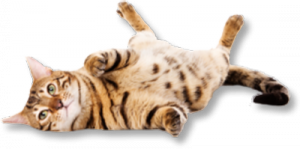A twitching tail, a stare, or a head butt are just a few of the ways our cats use body  language to communicate with us. Are you good at reading your cat’s body language? More than a few people have been nipped at or dealt with a growl or hiss when misreading what their cat is trying to say.
language to communicate with us. Are you good at reading your cat’s body language? More than a few people have been nipped at or dealt with a growl or hiss when misreading what their cat is trying to say.
Here are a few of a cat’s more common ways to communicate :
Arched back – That classic Halloween pose – arched back, hair standing on end and claws extended – is a very clear message. This is a cat in defensive mode because he or she is startled or frightened. Your best bet is to give your cat some space.
Belly rubs – This is one form of communication that is often misread. Cats roll on their back and show their belly when relaxed. Often, people read this as a sign that it’s time for a belly rub and get nipped at in the process. You need to find out if your cat is issuing you an invitation and actually enjoys belly rubs.
Pupils – You can find out a lot about a cat’s mood by their pupils. A fearful cat will have their pupils wide open so that they can see as much as possible while an angry cat tends to have constricted pupils.
Eyes have it – If a cat blinks slowly at you, it’s a sign of acceptance. Often a cat will stare to show that there is no desire to fight…but you need to know your stares. A dominant cat will stare at adversaries to show who is dominant.
Ears – If a cat’s ears are flat against his or her head, that cat is anxious or fearful. If the ears are alert and forward, it’s time to play.
Head butting – When your cat butts his or her head up against you or rubs his head on you, it’s one of the ways that a cat marks his territory with pheromones secreted from the forehead and cheeks. If your cat does this in a home with multiple cats, it helps them familiarize scent. When they head butt with you, it’s a sign of deep affection.
Kitty kisses – Adult cats groom their babies to take care of them. When your own cat licks or appears to be grooming you, it’s not only a sign of affection, it’s another way for your kitty to lay claim to you.
Kneading or making biscuits – This is when a cat presses his or her front paws against you or another animal. Kittens make this motion to stimulate milk flow when nursing. When your cat kneads or makes biscuits on you, it’s sign of affection and they shouldn’t be shooed away.
Overstimulation – Some cats will nip or bite when they are over stimulated by too much petting or playing. If your cat poofs up, his tail twitches or she is starting to make a negative vocalization, it’s time to step away. In a multi-cat household, it’s important to know the signs before a more dominant cat strikes against one that is more reserved.
Playful – Ears forward, tail up, whiskers forward, pupils somewhat dilated. Playing is hunting behavior; your cat may stalk his prey (a toy, a housemate, you) and then attack. Watch for a slightly raised rear end and butt wiggle before he or she pounces. This is all normal, healthy behavior in cats.
Tails have it – There is a happy swish of the tail and a fast moving twitch or thump of the tail. If you cat’s tail is twitching or thumping, he or she is agitated and it’s a good time to back off. Also, beware if your kitty’s hair is standing on end.
Talking cat – Purrs generally mean that a cat is happy, but a very sick cat may also purr. A cat’s meow means so many things – wanting to play, go into a closed room, get fed or a warning if your cat is getting agitated. It’s important to learn how to distinguish your cat’s meows to better communicate with him or her. If your cat is upset, listen for a grumbling sound, hissing or a growl – all mean watch out and keep your distance.
Talking cat part 2 – A cat tends to howl and yowl in a long drawn out fashion when distressed. This could be because they are in pain, locked in a place they don’t want to be or in heat. On the other hand, a cat’s chirps and trills are a way of communicating with each other or you (feed me please). They also tend to chirp in a more clipped manner when watching “critter theater” from the windows.
Time to play – Playing is part of a cat’s hunting behavior and they do a lot of little things to indicate that’s what they are ready to do. If your cat’s tail is up, ears are forward, and pupils slightly dilated, it’s time to play. Just watch for the butt wiggle and pounce before his or her favorite toy goes under attack.
If you would like to schedule an appointment for your cat click here : http://northernilcatcliniccom.web.siteprotect.net/schedule-appointment/